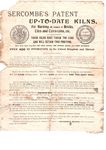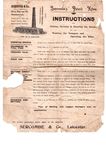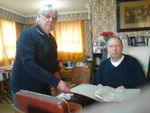What Foxton's moa-hunter site can tell us? - Historic Places ...
←
→
Page content transcription
If your browser does not render page correctly, please read the page content below
Newsletter of Historic Places
Manawatu—Horowhenua
Number 16 December 2020
What Foxton’s moa-hunter site can tell us?
In 1963 a local farmer near Foxton was surprised to find a massive shell midden on his property. What turned out to
be an early Maori ‘moa-hunter’ settlement site was excavated over the next ten years by a team of archaeologists
including Dr Bruce McFadgen.
Bruce spoke to a public meeting in Foxton on Sunday 6th December about his findings. And yes, now that he’s retired
some 55 years later, he hopes to finally ‘write the site up’ in an upcoming book.
The site was in the sand dunes north of Foxton Beach, probably close to the former Manawatu River course, and
dates to the 1300s and 1400s AD. The 30 foot long midden contained moa bones, a wide variety of birds, fish, cock-
les, mud snails and tuatua. The tiny land snails found indicate that the site was a dry forest area although it is now
covered with peat wetland. Structures included a house, cook house and windbreak against those coastal winds.
The stone artefacts – argillite from Nelson, chert from Wairarapa, obsidian from the Bay of Plenty , even nephrite
from the deep south – show that even then there was trading the length of New Zealand.
More importantly than the site’s contents, Dr McFadgen commented it reveals the effect of environmental change.
Coastal subsidence, possibly even an earthquake, dropped the site as much as two metres causing it to be flooded
and turned into wetland. Nationwide, small early Maori settlements moved from the coast to pa and other settlements
inland.
The Manawatu has also been subject to the ongoing growth of new sand dunes along the coast and their relentless
march inland. Potential early Maori settlement sites could be as deep as two to six metres underground [the recent
Otaki motorway may expose more]. But at present, the Foxton site remains a rarity, the only early Maori / Polynesian
site on this coast between Porirua and Patea.
Your nominations please
In 2021 the Palmerston North City Council will review the historic places listed in its District Scheme, a project it is
required to do on a ten-yearly basis. The past decade has seen a few changes to this city, not least that Bunny-
thorpe, Linton and Longburn now fall within its legal boundaries. This is our chance to nominate hitherto unconsid-
ered places for protection in the District Scheme. They need not be houses, and they need not be that old – the
current scheme includes the 1960s Dong Sheng Market on Rangitikei Street with its terrazzo front, war memorials
and a railway culvert at Milson. What might be left for example from the construction of the electricity sub-station at
Bunnythorpe? Or of the boarding houses for the first freezing workers at Longburn? The City Council ask only that
the places be important in the social or cultural life of this city, or have technological or architectural significance.
Historic Places Manawatu-Horowhenua would be happy to take your nominations and write them up in Council-
speak for the District Scheme. Please contact Chairwoman, Cindy Lilburn at cindy.lilburn@xtra.co.nz
1Cushla Scrivens was surrounded by family members for her investiture at Government House, Welllington on 23 Oc-
tober. From Left: Cushla’s brother Don, sister Marcia, Paddy’s sister Janet, Sir David, Dame Patsy, Cushla, Tim,
Tina, Don’s wife Barbara
The last traces of a one time landmark in Broadway. St. Pauls Methodist Church in the final stages of demolition.
2Local History Week Celebrated in Palmerston North
Local History Week 2020 actually kicked off a day early
Sunday 1 November with the 125th Jubilee Anniversary of Caccia Birch House
with a free garden party for the community. Many local groups were represent-
ed with displays in the house including Historic Places Manawatu-Horowhenua
and the Hoffman Kiln. Mayor Grant Smith officially opened the week on Mon-
day 2nd November with the Local Historian 2020 Award going to Val Burr and
the Local History Article for 2018 – 2020 going to Simon Johnson. Following
the ceremony Margaret Tennant talked about the new local history book City at
the Centre: a history of Palmerston North, and described how individual stories
can illustrate larger themes.
LEFT: Image of book cover, City at the Centre: a history of Palmerston North.
Tuesday 3rd November: Leanne
Hickman spoke about Leary’s
Pharmacy Ltd and the history of
pharmacy in Palmerston North.
Later in the day Leanne and Tina
White hosted a Terrace End
Cemetery Tour by Twilight which
gave people a chance to ‘meet’
some of the interesting residents
of the cemetery.
Thursday 5th November: Cindy Lilburn took guests on a tour of Cuba
Street showing the wealth of 1900s Edwardian shop buildings which
recalled the street’s once busy past.
ABOVE: Participants in the Terrace End Cemetery
Tour learned the stories behind the graves.
Saturday 7th November: Margaret Tennant
joined guests on a tour of Te Hotu Manawa I
Rangitāne O Manawatū Marae. The tour
began with a pōwhiri and provided opportuni-
ties to learn about the tikanga with korero
and pātatai, and a tour of the grounds.
Sunday 8th November: The Hoffman Kiln
was opened from 12 – 4 pm to allow visitors
to explore the kiln and its surrounds and
learn some of the kiln’s finer points. Also the
Palmerston North Electric Power Station was
also opened at the same time for tours.
ABOVE: A group visit to Te Hotu Manawa ō Rangitāne marae at Maxwell’s line was a
highlight of Local History Week. Terry Hapi (centre) hosted the tour. Leanne Hickman
Photograph supplied by Christina Winitana.
HISTORIC PLACES MANAWATU-HOROWHENUA COMMITTEE
President: Cindy Lilburn cindy.lilburn@xtra.co.nz
Secretary: Margaret Tennant
Treasurer: Bill Bendall junnbil@extra.co.nz 8 Manuka Street, Palmerston North (for posted mail to HPMH)
Committee: Don Irvine, David Chapple, Ian Robertson, Margaret Tennant, Pauline Knuckey.
————————————————————————————————————————
MEMBERSHIP SUBSCRIPTIONS 2020-2021 ARE NOW DUE
To renew your membership please select one of the payment options below.
Individual membership $20 ____________ Name ________________________
Family membership $25 ____________Email _______________________
Donation ____________
TOTAL ____________ PAYMENT OPTIONS
Internet Banking 15-3977-0028377-00 (Your name as a reference)
Cheque payable to Historic Places Manawatu-Horowhenua to 8 Manuka St Palmerston North 4410
3A SPOTLIGHT ON CUBA STREET
Our contribution to Palmerston North’s Local History Week
this year was an afternoon stroll down Cuba Street from the
Rangitikei Street end to the former Carlton, now the Distinc-
tion Hotel.
Once a quiet rustic back street to the Square, from the
1900s Cuba Street began to fill with businesses. The first
was an assortment of small food shops of which the tiny
two-storey takeaways building on the corner of Campbell
Street is one: this began life in the early 1900s as a combi-
nation confectionery and dressmaking shop.
The street has been home to three of Palmerston Fire Sta- ABOVE: The postcard ‘West View’(above right), enclosed from the
Manawatu Heritage website shows the corner of George and Cuba
tions [now the site of Crank It]; the second built in 1910 Street about 1909 and is the earliest known image of the street.
where Harvey Norman is now, and the third further along in
the 1920s currently the site of the Civil Defence building. With each station the transport upgraded from human-
powered, to horse-drawn engines and finally motor transport.
Those first fire-fighters certainly had to be fit when they pulled
their own hose reels to the fires.
Motor transport was the lifeblood of the first block in Cuba Street,
perhaps because Rangitikei Street, the ‘farmers street’ was just
around the corner. Where better to catch a farmer looking for a
new car? By the 1920s Cuba Street had several garages, a car
upholsterer and tyre services. Pink and Collinson [motorbikes] is
perhaps the best known, where the Golden Roast Takeaways is
now.
Last but not least, Cuba Street had a large resident population
upstairs. The street offered an assortment of one and two-
bedroom flats above the shops for the many singletons who had
ABOVE: A float in the 1952 Palmerston North Jubilee parade come to work in Palmerston’s shops, businesses and government
passing down Cuba Street. The side shown is from Rangitikei
Street – the wooden buildings are now the car park of Bris- departments. The street may have been short but must have been
coes. Image from the Manawatu Heritage website lively before ‘big box’ businesses swallowed its variety.
Historic Places Manawatu-Horowhenua Chairwoman’s report for 2019 - 2020
This society is committed to preservation, promotion and advocacy for historic buildings and sites in the Manawatu-
Horowhenua region. 2020 has been an interrupted year but nevertheless I can feel proud of what our committee has
achieved in the nine months available to us.
Earthquake strengthening
This legal requirement remains the strongest current threat to our built heritage. Owners of earthquake-prone build-
ings now have only a year for their properties to be assessed by engineers. By 2026 they must either earthquake
strengthen or demolish their properties. Decisions over this coming year will indicate whether owners have commit-
ted to the remedial work necessary or will forego preserving their heritage buildings.
The law affects not only pre-1930s masonry buildings, but many constructed as recently as the 1950s.
St Paul’s Methodist church, Palmerston North, built in 1911, has already been victim to its earthquake vulnerability
and the changing needs of its congregation. The building was demolished just after the lockdown in May 2020. Our
society’s financial contribution of $1000 however assisted in the removal of three historic windows from the church,
which were passed to Te Manawa in October last year.
Our committee also made a submission in August this year to the resource consent for alterations to All Saints
Church, Palmerston North. Although we approved of the proposed earthquake- strengthening work, the committee
were split equally on the proposed extension across the front which gives the church greater usability but interrupts
the heritage façade. For this reason we have not progressed to argue a case at the Environment Tribunal for the
church.
I am pleased to report however that several years of advocacy by committee member Don Irvine has been success-
ful in Manawatu District. Six Feilding owners of heritage commercial buildings have adopted his recommendation that
they hire a structural engineer in common, using the EQUIP heritage fund available from central government. Sadly
this funding opportunity is due to cease shortly.
In September last year I attended the annual Historic Places Aotearoa conference in Gisborne. [This national organi-
zation is supported in part by your membership subscriptions]. Earthquake strengthening was high on the agenda
and two new legal tweaks [tax deductibility and percentage value at which strengthening is required] should ease
Continued on page 5
4Continued from page 4
matters for commercial property owners of heritage buildings. Government policy makers and Heritage NZ have
made efforts to attend the past HPA conferences so that we can ‘bend their ears’ with our concerns. This year’s con-
ference will be in Whanganui in October. We have been members for three years, Historic Places Aotearoa has been
functioning for five. Time soon to assess how this is going?
Preservation
The Opiki Toll Bridge, a landmark on the Manawatu River, now has visibly broken cables. Our preservation concerns
have been hampered by the fact that the bridge itself is still privately owned and the land on either side belongs to
Horizons.mw. Despite a formal submission and numerous attempts to liaise with Horizons staff, we have met with no
success. Their own built heritage is not one of Horizon’s priorities. Our committee has since turned recently to Herit-
age NZ as the bridge has their Category I rating. There will be no easy solution given the ownership issue and the
need for a viable future purpose.
The Hoffman kiln in Palmerston North was rescued in the 1970s due to Manawatu Historic Places Trust efforts. Two
of our committee members, David Chapple and Don Irvine, now serve on the Kiln Trust. They have been holding
regular volunteer working bees, and are investigating re-pointing of the masonry.
Wheriko church near Bulls once fell within our old boundaries as a Branch Committee. It has a Category I rating as
an early Maori Anglican church built in 1862. We were pleased to make a small contribution of $250 for old times’
sake for urgently needed roof flashing.
We must also be heartened by the appointment of Victoria Edmonds as the new Palmerston North City Council Herit-
age Planner. Indications are she will be strongly pro-active in heritage preservation, and is keen to work with us. Mat-
thew McKay, her predecessor, has moved to Manawatu District Council and continues to liaise with us. Unfortunately
we have had minimal contact this year with Horowhenua District Council due to turnover of their planning staff and
their lack of dedicated heritage planners.
Promotion
Heritage stories give meaning to our historic places. This year the committee has completed three projects to pro-
mote our local past.
In early 2020 we delivered two panels to Te Takere, the Levin public library, detailing the history of the World War II
conscientious objectors camps at Shannon. The result of several years’ research by member Margaret Tate, the
panels are on a portable sandwich board we have purchased. The library tells us the displays have generated much
interest, and will be travelling to the Foxton branch shortly. The sandwich board is re-usable for other history displays
in the future, at a cost of approximately $300 each time for the panels’ graphics and manufacture.
Committee member Ian Robertson has recorded an oral history of the long-standing Pelco business on Tremaine
Avenue, Palmerston North. Their property was formerly a brickworks associated with the clay ‘Pit’ that also serviced
the Hoffman kiln. From the 1920s onwards the complex of buildings produced wooden ladders for the electrical
trade. The buildings were demolished in 2019; the oral history has grandson Bruce Woodward talking about his
memories of the business. This oral history has now been lodged in the Palmerston North City Library
Committee Chairwoman, Cindy Lilburn, again contributed to Palmerston North Local History Week 2019 with a
lunchtime walk along Broadway. This year – Cuba Street! The extensive research on all the buildings en route, will
also be placed in Palmerston North City
Committee Chairwoman, Cindy Lilburn, again contributed to Palmerston North Local History Week 2019 with a
lunchtime walk along Broadway. This year – Cuba Street! The extensive research on all the buildings en route, will
also be placed in Palmerston North City Council archives.
Attempts by our committee to organise field trips to historic sites have resulted in a disappointing response from
members, and at least two had to be cancelled because of low numbers. A proposal we will consider is that we work
in together with the U3A group from the outset to hold trips in common. Twelve people is our minimum number, oth-
erwise we may have to rethink this aspect of our activities.
Our appreciation goes to …
Long-standing HPMH Secretary, Cushla Scrivens, has indicated she will not be standing this year on the committee.
We would like to acknowledge her stalwart work over the past twelve years behind all that we do, and wish her well
for the future. Congratulations are also in order as Cushla will be receiving her QSM for services to history shortly at
Government House.
Long-time committee member, Margaret Tate, has also tendered her resignation after twenty-five years with our local
Historic Places Trust. We are grateful particularly for her establishment of our website, and her historical research
into the local flax industry and conscientious objectors’ camps.
I must sadly note the passing of Garry O’Neill who served as our Treasurer from 2004 – 2006, and was wily in track-
ing down funding sources for our projects. Garry’s three books on the story of Palmerston North suburbs are a fitting
memorial to his heritage interests.
This is a subtle hint therefore that fresh members would be welcomed on the committee. Our committee is a good
team and keen to continue working enthusiastically for heritage in the coming year.
Thank you for your ongoing support. Cindy Lilburn Chairwoman
5A MODEL OF THE HOFFMAN KILN
The Hoffman Kiln Trust was recently donated a special model of the Hoff-
man Kiln, by Mr. Frank Sercombe, Great Grandson of Mr. William
Sercombe, who patented the Sercombe Kiln System as a derivative of the
original Hoffman concept. The model was in the keeping of the Sercombe
family until a few months ago when it was donated to the Kiln Trust.
William’s son Francis (Frank) emigrated to New Zealand around 1904,
and was agent for the Sercombe Kiln system, on which the Palmerston
North Hoffman Kiln is based.
It is thought he would have brought the model from England, and that he
would have used it to demonstrate the kiln’s operational principles – so it
is around 120 years old. He would have been able to open up the model
to show the various internal shafts and ducts, illustrating how the Kiln
worked.
Included in the gift were copies of the advertising brochures, and instruc-
tion sheets to assist in selling the advantages of this particular kiln to po-
tential buyers. Although copies of these have been included in Jim Lun-
dy’s book Nine Thou-
sand Bricks a Day – it
is great to have original copies in the care of the trust.
The model was displayed at the recent Open Day for the Kiln.
The Open Day, held as part of Heritage Week, was also an op-
portunity to show the progress made in fitting out the shed build-
ing that stands beside the Kiln. It will house displays of the kiln,
including bricks and other artifacts. This building has been
named as the “Jim Lundy Building” and a function will be held to
mark this when the exterior is tidied up. This is of course in
recognition of the tremendous work undertaken over many years
by Jim Lundy. Without his work on site and his lobbying, it is
doubtful if the Kiln would still be there.
The Trust has also been the recipient of some interesting display
panels from Gary Tonks from Wellington. Mr. Tonks’ family oper-
ated brickworks in the Wellington region, and he describes him-
self as a Brickologist. The Kiln Trust hosts a work party on the sec- Photo above right: David Chapple with Mr. Frank
Sercombe
ond Sunday of every month from 1.30 – 3.30pm, to carry out
maintenance and upgrading work, and anyone is warmly invited to come – even to just have a look to see what is
going on. David Chapple
Pages from a brochure advertising Sercombe’s kilns
6You can also read



























































